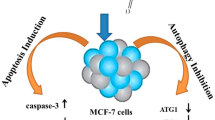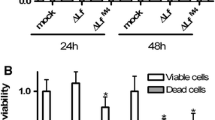Abstract
Recently, the study of autophagy and its mechanism on the cancer cell growth process has received much attention. lactoferrin (Lf) is a glycoprotein with various biological activities, including antibacterial, antiviral, anti-cancer, etc. In the present study, the effect of different concentrations of lactoferrin on the expression of ULK1 and ATG13 genes was evaluated in breast cancer cell line MCF7 using real-time PCR technique as well as the molecular mechanism of these two genes and their proteins in the autophagy pathway and the relationship between lactoferrin and these proteins were investigated by bioinformatics studies. The result showed that the expression of the ULK1 gene at a concentration of 500 μg/ml of lactoferrin was significantly (P < 0.007) increased compared to the control and two other concentrations. Also, the expression of the ATG13 gene at all three concentrations was not significantly different from each other and compared to the control (P = 0.635). In the immunoblot of ULK1 protein at a concentration of 500 µg, more protein expression was observed. The binding mode of lactoferrin with ULK1, ATG13, and ATG101 proteins was obtained using docking. According to docking results, the N-lobe region of lactoferrin interacts with the PS domain of the ULK1 protein, and the N-lobe region of lactoferrin interacts with the horma domain of the ATG 13 and ATG101 proteins. The results show that lactoferrin, in addition to acting on the gene, interacts with ULK1, ATG13, and ATG101 proteins. Since all three proteins are components of the autophagy initiation complex, lactoferrin can induce autophagy in this way.










Similar content being viewed by others
Data availability
The datasets analyzed during the current study are available from the corresponding author on reasonable request.
References
Russo, M., & Russo, G. L. M. (2018). Autophagy inducers in cancer. Biochem Pharmaco, 1(153), 51–61.
Martina, J. A., Chen, Y., Gucek, M., & Puertollano, R. (2012). MTORC1 functions as a transcriptional regulator of autophagy by preventing nuclear transport of TFEB. Autophagy, 8, 903–914. https://doi.org/10.4161/auto.19653.
Sridharan S, Jain K. Basu A, Regulation of autophagy by kinases. Cancers 3, 2630–2654. https://doi.org/10.3390/cancers3022630
Aizawa, S., Hoki, M., & Yamamuro, Y. (2017). Lactoferrin promotes autophagy via AMP-activated protein kinase activation through low-density lipoprotein receptor-related protein 1. Biochem Biophys Res Commun, 493(1), 509–513.
Mukhopadhyay, S., Sinha, N., Das, D. N., Panda, P. K., Naik, P. P., & Bhutia, S. K. (2016). Clinical relevance of autophagic therapy in cancer: Investigating the current trends, challenges, and future prospects. Crit Rev Clin Lab Sci. 53(4), 228–252.
Galluzzi, L., Buqué, A., Kepp, O., Zitvogel, L., & Kroemer, G. (2017). Immunogenic cell death in cancer and infectious disease. Nat Rev Immunol., 17.2, 97–111.
Santana-Codina N, Mancias J, Kimmelman AC, The role of autophagy in cancer. Annu Rev Cancer Biol. 1, 19–39.
Galluzzi, L., Pietrocola, F., Bravo‐San Pedro, J. M., Amaravadi, R. K., Baehrecke, E. H., Cecconi, F., & Kroemer, G. (2015). Autophagy in malignant transformation and cancer progression. The EMBO J., 34.7, 856–880.
Wilde, L., Tanson, K., Curry, J., & Martinez-Outschoorn, U. (2018). Autophagy in cancer: a complex relationship. Biochem J., 475.11, 1939–1954.
Wu, C. P., & Ambudkar, S. V. (2014). The pharmacological impact of ATP-binding cassette drug transporters on vemurafenib-based therapy. Acta Pharm Sin B., 4.2, 105–111.
Ouyang, L., Shi, Z., Zhao, S., Wang, F. T., Zhou, T. T., Liu, B., & Bao, J. K. (2012). Programmed cell death pathways in cancer: a review of apoptosis, autophagy and programmed necrosis. Cell Prolif., 45. 6, 487–498.
Zhao, Y. G., Codogno, P., & Zhang, H. (2021). Machinery regulation and pathophysiological implications of autophagosome maturation. Nat Rev Mol Cell Biol, 22, 733–750.
Hara, T., Takamura, A., Kishi, C., Iemura, S. I., Natsume, T., Guan, J. L., & Mizushima, N. (2008). FIP200, a ULK-interacting protein, is required for autophagosome formation in mammalian cells. J Cell Biol., 181.3, 497–510.
Randhawa, R., Sehgal, M., Singh, T. R., Duseja, A., & Changotra, H. (2015). Unc-51 like kinase 1 (ULK1) in silico analysis for biomarker identification: a vital component of autophagy. Gene, 562.1, 40–49.
Li, F., Chung, T., & Vierstra, R. D. (2014). AUTOPHAGY-RELATED11 plays a critical role in general autophagy-and senescence-induced mitophagy in Arabidopsi. The Plant Cell, 26.2, 788–807.
Hara, T., & Mizushima, N. (2009). Role of ULK-FIP200 complex in mammalian autophagy: FIP200, a counterpart of yeast Atg17. Autophagy, 5.1, 85–87.
Hosokawa, N., Hara, T., Kaizuka, T., Kishi, C., Takamura, A., Miura, Y., & Mizushima, N. (2009). Nutrient-dependent mTORC1 association with the ULK1–Atg13–FIP200 complex required for autophagy. Mol Biol Cell., 20.7, 1981–1991.
Ganley, I. G., Lam, D. H., Wang, J., Ding, X., Chen, S., & Jiang, X. (2009). ULK1· ATG13· FIP200 complex mediates mTOR signaling and is essential for autophagy. J Biolo Chem, 284.18, 12297–12305.
Mercer, C. A., Kaliappan, A., & Dennis, P. B. (2009). A novel human Atg13 binding protein, Atg101, interacts with ULK1 and is essential for macroautophagy. Autophagy, 5.5, 649–662.
Dong, Z., Wang, Y., Liu, W. Z., Shu, Q. S., Cai, J., & Tang, Y. C. (2020). AMPK/mTOR signaling in autophagy regulation during cisplatin-induced acute kidney injury. Front Physiol, 11, 1679.
González-Chávez, S. A., Arévalo-Gallegos, S., & Rascón-Cruz, Q. (2009). Lactoferrin: structure, function and applications. Int J Antimicrob Agents, 33.4, 301–e1.
Stevens, R. G., Jones, D. Y., Micozzi, M. S., & Taylor, P. R. (1988). Body iron stores and the risk of cancer. N Engl J Med., 319.16, 1047–1052.
Grosso, R. A., Caldarone, P. V. S., Sánchez, M. C., Chiabrando, G. A., Colombo, M. I., & Fader, C. M. (2019). Hemin induces autophagy in a leukemic erythroblast cell line through the LRP1 receptor. Biosci Rep., 39, 1.
Sui, X., Chen, R., Wang, Z., Huang, Z., Kong, N., Zhang, M., & Pan, H. (2013). Autophagy and chemotherapy resistance: a promising therapeutic target for cancer treatment. Cell Death Dis., 10, e838.
Benkert, P., Biasini, M., & Schwede, T. (2011). Toward the estimation of the absolute quality of individual protein structure models. Bioinformatics, 27, 343–350.
Wiederstein, M., & Sippl, M. J. (2007). ProSA-web: interactive web service for the recognition of errors in three-dimensional structures of proteins. Nucleic Acids Res., 35, W407–W410.
Anderson, R. J., Weng, Z., Campbell, R. K., & Jiang, X. (2005). Main-chain conformational tendencies of amino acids. Proteins, 60.4, 679–89.
Desta, I. T., Porter, K. A., Xia, B., Kozakov, D., & Vajda, S. (2020). Performance and its limits in rigid body protein-protein docking. Structure, 28. 9, 1071–1081.
Kozakov, D., Hall, D. R., Xia, B., Porter, K. A., Padhorny, D., Yueh, C., Beglov, D., & Vajda, S. (2017). The ClusPro web server for protein-protein docking. Nature Protocols, 12.2, 255–278.
Zhou, S., Zhao, L., Kuang, M., Zhang, B., Liang, Z., Yi, T., & Zhao, X. (2012). Autophagy in tumorigenesis and cancer therapy: Dr. Jekyll or Mr. Hyde. Cancer Lett., 323.2, 115–127.
Zhang, Y., Nicolau, A., Lima, C. F., & Rodrigues, L. R. (2014). Bovine lactoferrin induces cell cycle arrest and inhibits mTOR signaling in breast cancer cells. Nutr Cancer, 66.8, 1371–1385.
Bononi, A., Agnoletto, C., De Marchi, E., Marchi, S., Patergnani, S., Bonora, M., & Pinton, P. (2011). Protein kinases and phosphatases in the control of cell fate. Enzyme Res., 2011, 329098 https://doi.org/10.4061/2011/329098.
Mizushima, N. (2010). The role of the Atg1/ULK1 complex in autophagy regulation. Curr Opin Cell Biol., 22. 2, 132–139.
Tang, J., Deng, R., Luo, R. Z., Shen, G. P., Cai, M. Y., Du, Z. M., & Zhu, X. F. (2012). Low expression of ULK1 is associated with operable breast cancer progression and is an adverse prognostic marker of survival for patients. Breast Cancer Res Treat., 134. 2, 549–560.
Khan, S. H., & Kumar, R. (2012). Role of an intrinsically disordered conformation in AMPK-mediated phosphorylation of ULK1 and regulation of autophagy. Mol Biosyst., 8.1, 91–96.
Xue Y, Wang D, Peng D. (2021) Bioinformatics Technologies in Autophagy Research In. Autophagy: Biology and Diseases, Springer, Singapore, 387–453.
Lee, J. W., Park, S., Takahashi, Y., & Wang, H. G. (2010). The association of AMPK with ULK1 regulates autophagy. PloS one, 5.11, e15394.
Dwivedi, P., & Greis, K. D. (2017). Granulocyte colony-stimulating factor receptor signaling in severe congenital neutropenia, chronic neutrophilic leukemia, and related malignancies. Exp Hematol, 46, 9–20.
Dwivedi, P. (2021). ROS mediated apoptotic pathways in primary effusion lymphoma: comment on induction of apoptosis by Shikonin through ROS-mediated intrinsic and extrinsic pathways in primary effusion lymphoma. Transl Oncol., 14, 101061.
Xiao, Y., Monitto, C. L., Minhas, K. M., & Sidransky, D. (2004). Lactoferrin down-regulates G1 cyclin dependent kinases during growth arrest of head and neck cancer cells. Clin Cancer Res., 10, 8683–8686.
Hsu, Y. H., Chiu, I. J., Lin, Y. F., Chen, Y. J., Lee, Y. H., & Chiu, H. W. (2020). Lactoferrin contributes a renoprotective effect in acute kidney injury and early renal fibrosis. Pharmaceutics, 12.5, 434.
Dwivedi, P., Rodriguez, J., Ibe, N. U., & Weers, P. M. M. (2016). Deletion of the N- or C-terminal helix of apolipophorin III to create a four-helix bundle protein. Biochem, 5.55(26), 3607–3615.
Behrends, C., Sowa, M. E., Gygi, S. P., & Harper, J. (2010). Network organization of the human autophagy system. Nature, 466.7302, 68–76.
Denton, D., Nicolson, S., & Kumar, S. (2012). Cell death by autophagy: facts and apparent artefacts. Cell Death Differ, 19.1, 87–95.
Acknowledgements
The authors gratefully acknowledge the facility and assistance offered by the Cell and Molecular Biology Lab, Sari Agricultural Sciences and Natural Resources University.
Funding
The present paper was extracted from Fatemeh Moradian’s grant at Sari Agricultural Sciences and Natural Resources University.
Author information
Authors and Affiliations
Corresponding author
Ethics declarations
Conflict of interest
The authors declare no competing interest.
Additional information
Publisher’s note Springer Nature remains neutral with regard to jurisdictional claims in published maps and institutional affiliations.
Rights and permissions
Springer Nature or its licensor holds exclusive rights to this article under a publishing agreement with the author(s) or other rightsholder(s); author self-archiving of the accepted manuscript version of this article is solely governed by the terms of such publishing agreement and applicable law.
About this article
Cite this article
Karabi, Z., Moradian, F. & Kheirabadi, M. The effect of lactoferrin on ULK1 and ATG13 genes expression in breast cancer cell line MCF7 and bioinformatics studies of protein interaction between lactoferrin and the autophagy initiation complex. Cell Biochem Biophys 80, 795–806 (2022). https://doi.org/10.1007/s12013-022-01097-x
Received:
Accepted:
Published:
Issue Date:
DOI: https://doi.org/10.1007/s12013-022-01097-x




